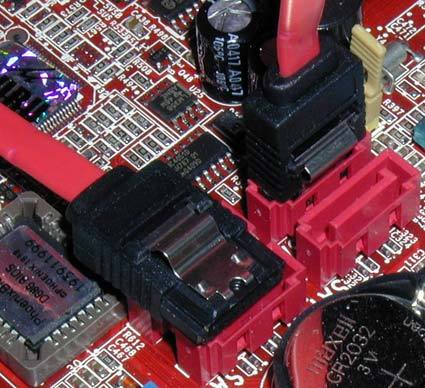The RAID 6 Areca ARC-1120 One-ups RAID 5 Controllers
Technical Specifications
| Areca ARC-1120 | |
|---|---|
| Bus | PCI-X 133 MHz |
| XOR Engine | Intel 80332 |
| SATA Ports | 8x SATA II |
| Cache | 128 MB DDR333, ECC |
| RAID Levels | 0, 1, 0+1, 3, 5, 6, JBOD |
| Features | Online RAID RoamingOnline RAID Level MigrationOnline Stripe Size Migration64 Bit LBARedundant Flash ImageInstant Availability / Background Init.Browser-based RAID Management Softw.Multi-Adapter-SupportBattery Backup Module optionalNotification: Email |
The SATA II ports already offer locks.
The ARC-1120 In Practice
Rebuild
A RAID 6 rebuild process for two failed Western Digital WD740 Raptor-type hard drives took 25 minutes. Naturally, for the purpose of comparison, we also created a RAID 5 array, removed one drive and started the restoration process here too: at 21 minutes, the time needed was barely shorter. This puts the Areca controller on a par with the 9500-12S from 3Ware, which, given the same starting situation, also needed 21 minutes.
RAID Level Migration
RAID 6 requires two drives in the array to be used just for checksums, so it costs more storage than RAID 5. If space on the array runs out, a short-term solution is to convert the RAID 6 array to a RAID 5 one. This adds back the capacity of one drive, at the cost of reducing the fail-safe system from two drives to just one. To switch from RAID 6 to RAID 5, the ARC-1120 needed just under 54 minutes - not bad, considering the size of the RAID array (8 fast hard drives at 74 GB each).
If you start out by choosing the fast but zero-security RAID 0, you will be left out in the cold if you want to migrate. The reason is that introducing a RAID mode that works with parity data reduces the usable storage capacity of the array. If the RAID array were filled up with data, no more space would be available for the parity information. Switching from RAID 5 to RAID 6 is not easily done, for the same reason.
In contrast, it is easier to migrate from an existing RAID 5 array to RAID 3 or even to RAID 0, because the available capacity either stays the same or increases. If a migration frees up additional memory, it can be added to the RAID set after the migration process is finished.
Get Tom's Hardware's best news and in-depth reviews, straight to your inbox.
Current page: Technical Specifications
Prev Page Areca ARC-1120 Next Page The Rivals: Broadcom/Raidcore BC4000 And 3Ware/AMCC 9000 Series
Patrick Schmid was the editor-in-chief for Tom's Hardware from 2005 to 2006. He wrote numerous articles on a wide range of hardware topics, including storage, CPUs, and system builds.
